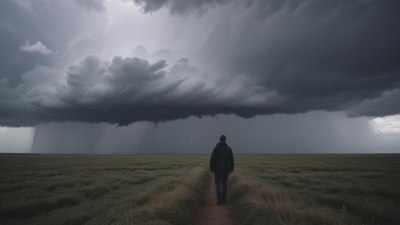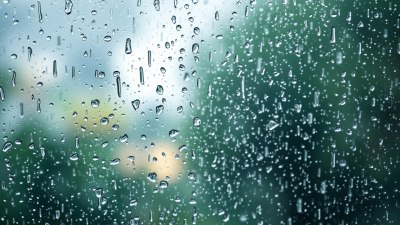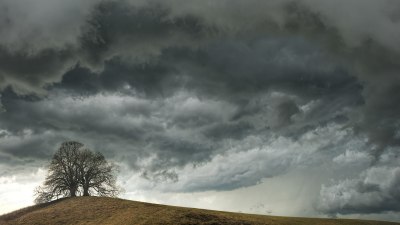How to Accept You’ll Never Fully Trust a Weather App Again
Explore the reasons behind our skepticism of weather apps and how to cope with unpredictable forecasts.

This image was created with the assistance of Freepik
In the era of smartphones and digital convenience, weather apps have become a staple for most of us. With just a tap, we can know the forecast for today, tomorrow, or even the whole week. However, as we rely more on these applications, a sneaking suspicion may arise - how accurate is the information they're providing? Over time, many individuals find themselves grappling with the notion that they may never fully trust a weather app again.
This reluctance to entrust our daily plans to a weather app's forecast often stems from past experiences. One day, a bright sunny prediction transforms into a downpour. The next, a seemingly harmless cloudiness turns into a full-blown storm. These scenarios leave us wondering why we placed our faith in technology when the results were wildly misleading.
The Science Behind Weather Predictions
Firstly, it’s crucial to understand the fundamentals of meteorology. Weather forecasting relies on complex models that simulate the atmosphere's behavior. These models analyze a plethora of variables, including temperature, humidity, wind speed, and more. However, the atmosphere is an intricate system where small changes can drastically alter outcomes. This chaos theory aspect of meteorology means that even the best forecasts can be off-mark.
The accuracy of a forecast decreases with the length of time until it is meant to be realized. For instance, while tomorrow's weather can often be predicted with considerable success, forecasts extending beyond a week can be likened to reading tea leaves. Weather apps may employ impressive technology, but they are still limited by the ever-changing nature of weather itself.
Real-Life Experiences with Weather Apps
Countless stories abound regarding extreme discrepancies between a predicted sunny day and reality. Take, for example, the weekend plans that had to be altered due to an unexpected storm. One friend might tell another, “I just checked my app, and it’s supposed to be perfect weather!” Only for them to find themselves drenched in rain by noon. Such unpredictabilities lead to repeated disappointments over time, reinforcing the belief that we can’t rely on these applications to dictate our plans.
Furthermore, anecdotal evidence often shows that different weather apps can provide conflicting forecasts. One app might indicate a sunny day with temperatures in the mid-70s, while another app suggests a chilly, rainy afternoon. With such discrepancies, it becomes hard to determine which app, if any, can be trusted. When faced with such uncertainties, users are left questioning the credibility of digital weather forecasting altogether.
The Emotional Toll of Weather Discrepancies
Weather is often linked to our emotions and feelings of comfort. A sunny forecast encourages outdoor activities, while rain can derail plans or even affect moods negatively. When a weather app fails to deliver, it can provoke frustration and anxiety. The emotional toll often further compounds skepticism. No one likes the feeling of being misled, especially when it involves planning outings with loved ones, days at the beach, or even trips out of town.
Moreover, the stakes can be higher when it comes to severe weather conditions. In storm-prone areas, knowing whether a storm warning is legitimate can sway crucial decisions. Whether to evacuate or stay put can often rely on accurate weather information. When the results from weather apps are not trustworthy, individuals might find themselves unprepared for dangerous situations. The doubt then lingers—a concoction of worry, angst, and mistrust—influencing future weather decisions.
Shifting Perspectives: Coping with Uncertainty
While the feeling of mistrust towards weather apps can dominate, there are ways to cope with this uncertainty. First and foremost, diversifying the sources of information can provide a more balanced viewing. Rather than relying solely on one weather app, users can check multiple platforms. Comparing forecasts helps to form a more comprehensive understanding of what to expect.
Another approach is to remain adaptable. Rather than deciding on plans based entirely on app predictions, it can be beneficial to consider alternative options. For instance, if there’s a chance of rain, have an indoor activity ready as a backup. Embracing a flexible mindset helps mitigate the emotional distress resulting from erroneous weather forecasts and empowers individuals to take control over their plans in the face of unpredictability.
Embracing a Healthy Skepticism
While fully embracing the unpredictability may be a tall order, a healthy skepticism can buffer the emotional fallout from disappointing forecasts. By acknowledging the limitations of technology and meteorological science, you cultivate a more realistic image of what these apps offer. Rather than placing absolute trust in the number displayed, consider it a starting point for discussion about your day’s activities.
Furthermore, being skeptical also involves engaging with the processes at play. Understanding how weather is forecasted, including the models and predictions behind apps, can foster appreciation for the complexity of forecasting. Such knowledge creates a foundation for informed discussions about weather patterns and adds value to the experience of checking your daily forecast.
Utilizing Weather Education Resources
If individuals are truly interested in refining their understanding of weather forecasts, several educational resources are available. Many meteorology programs offer free online courses that delve into the science of forecasting. Websites run by reputable meteorological organizations also provide infographics and articles that explain how different weather phenomena occur. Taking the time to educate oneself can lead to enhanced skills in interpreting weather information.
For those who are particularly interested in regional weather, local news stations often invest in personalized weather forecasts which can include insights from on-the-ground reporting. This close context can add reliability to forecasts. In many cases, knowing a trustworthy local meteorologist can enhance the accuracy of what you can expect for your immediate area.
The Future of Weather Forecasting
As technology advances, the potential for more precise weather forecasting is always on the horizon. Machine learning and artificial intelligence are being integrated into weather prediction models. These systems are designed to process vast amounts of data quickly, thereby potentially improving accuracy. While no app might ever offer perfection due to the unpredictable nature of the atmosphere, advancements in technology show promise for the future of forecasting.
Though the path to completely accurate weather predictions feels far off, recognizing the improvements and uncertainties could shape how we utilize and trust these applications moving forward. The seamless integration of updated technology into everyday weather apps might restore at least some level of confidence in forecasting.
A Path Forward
Ultimately, accepting that we won’t fully trust a weather app again doesn’t have to be a disheartening realization. It can be an empowering journey embracing knowledge, adaptability, and skepticism. By taking proactive steps to educate oneself, diversify sources, and embrace future advancements, individuals can find a way to coexist with the unpredictability that weather brings. It becomes a matter not of trust but of finding resilience in the face of uncertainty. Engaging with weather apps becomes more of a balanced partnership rather than lean entirely on a single forecast. Thus, while we may never fully trust a weather app again, we can forge a new path towards experiencing daily weather with a nuanced understanding and thoughtful approach.











